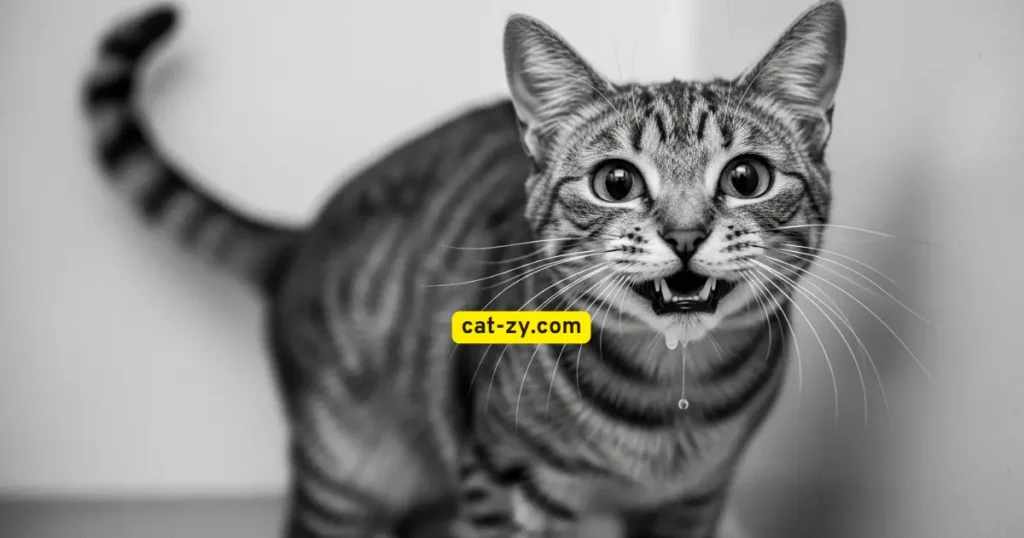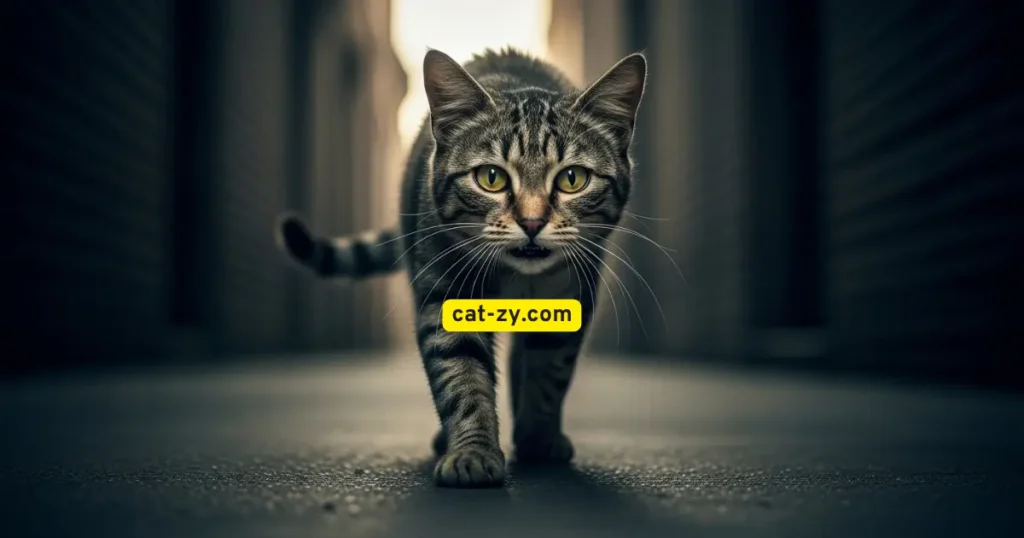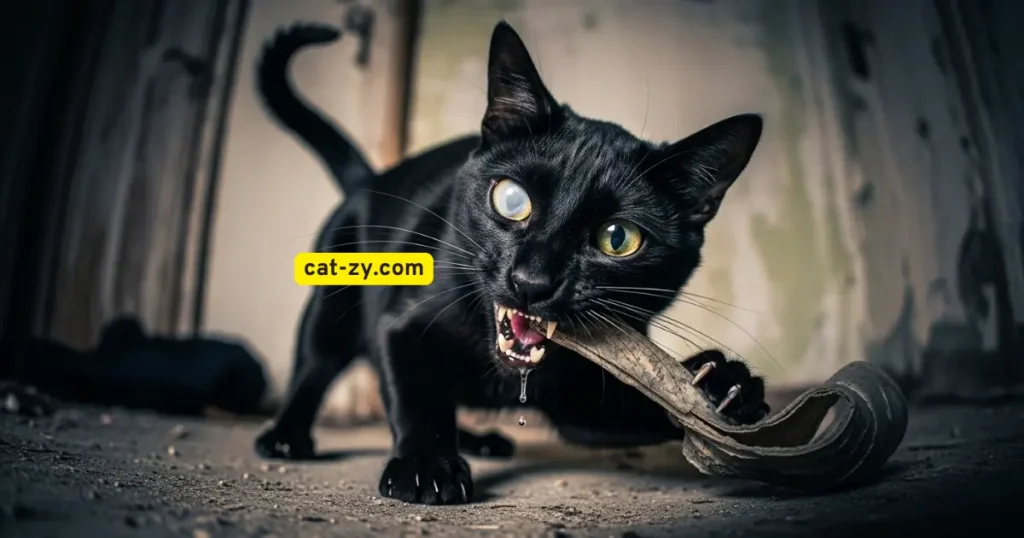Cats With Rabies Behavior: 5 Shocking Things to Watch For
As a cat owner, the thought of your pet getting rabies is scary. Rabies is a deadly virus spread through saliva, often from bites. Understanding cats with rabies behavior is key to protect your pet and family.
If your cat has rabies, spotting the signs early is vital. Cats with rabies behavior shows differently, making it hard to tell. Knowing the shocking signs helps you act fast, which could save lives.
In this article, we’ll look at the important symptoms to watch for. This way, you can protect your loved ones from harm.
Table of Contents
Understanding Rabies in Cats: A Deadly Neurological Disease
Cats with rabies behavior present serious issues that need immediate attention. Cats with rabies behavior results from a viral infection that attacks the nervous system. If not treated, it’s almost always fatal.
What Is Rabies and Why It’s So Dangerous
rabies comes from the saliva of infected animals, usually through bites. It travels to the brain, causing inflammation and damage. This leads to severe symptoms.
The virus can affect any mammal, including humans. The fatality rate for rabies is nearly 100% if post-exposure prophylaxis is not administered promptly.
The virus is zoonotic, meaning it can spread from animals to humans. This usually happens through bites or scratches that break the skin. It’s important to know the risks and take steps to prevent it.
How Cats Contract the Rabies Virus
Cats get rabies from bites by infected animals like raccoons, bats, or other rabid cats. The virus is in the infected animal’s saliva. It spreads when the saliva touches the cat’s mucous membranes or open wounds. Outdoor cats are at higher risk of developing cats with rabies behavior due to their potential exposure to wild animals that may be infected.
To lower the risk of rabies, keep your cat’s vaccinations current. Also, try to limit their contact with wild animals. Keeping your cat indoors is a great way to prevent rabies infection.
The Progression of Rabies: From Infection to Fatal Symptoms
Cats with rabies behavior demonstrate a serious and deadly disease progression. After infection, the virus moves through the cat’s nervous system. It eventually reaches the brain, causing severe symptoms.
Incubation Period: The Silent Phase
The incubation period is when the cat seems fine but the virus is growing. This time can be short or very long, lasting from days to years.
Prodromal Stage: First Warning Signs
In the prodromal stage, the cat starts showing signs of rabies. These can be changes in behavior, like being more irritable or tired. The cat might also stop eating or sound different.
Furious and Paralytic Forms of Rabies
Rabies can show up in two ways: furious and paralytic. The furious form makes the cat aggressive and hyperactive. The paralytic form causes paralysis, starting with the face and spreading.
Both forms are deadly, and the cat usually dies within days. Knowing these stages helps cat owners spot rabies early and protect themselves and their pets.
Cats with Rabies Behavior #1: Sudden Aggression and Personality Changes
One of the first signs of rabies in cats is sudden aggression. This can shock pet owners. It’s a big change that can make a friendly cat very aggressive.

From Friendly to Ferocious: Understanding the Transformation
A cat with rabies may become very aggressive without warning. This aggression can show as hissing, growling, or biting. These are not usual behaviors for the cat.
The rabies virus affects the cat’s nervous system. This leads to inflammation and irritation that changes how the cat acts.
This change from calm to aggressive can happen fast. It often surprises owners. It’s important to see this sudden change as a serious health sign.
How to Distinguish Rabies Aggression from Normal Territorial Behavior
Telling rabies aggression from normal territorial behavior is hard. Rabies aggression is often unprovoked and unpredictable. Territorial aggression usually has a clear reason, like another animal or person.
Watching how and when the cat acts aggressively can help figure out why. If your cat is very aggressive without a reason, think about rabies. This is especially true if your cat has been near animals that could carry rabies.
Shocking Behavior #2: Unusual Vocalization and Disorientation
Unusual vocalization and disorientation are key signs your cat might have rabies. This deadly disease creates cats with rabies behavior that affects brain functions. It leads to these alarming symptoms.
Strange Sounds and Excessive Meowing
Cats with rabies behavior often make unusual sounds like strange meows or high-pitched screams or growls. This is because the virus harms their brain. It’s a sign the disease is getting worse.
These vocal changes are not normal. They can mean your cat is in distress or crying for help. It’s a serious sign of a health problem like rabies.
Confusion, Circling, and Loss of Coordination
Disorientation is another big sign of rabies in cats. Infected cats seem confused or disoriented, often circling or stumbling. This is because the virus damages their brain.
They might have trouble walking or staying balanced. This is a heartbreaking sign of the disease getting worse. It’s important to know these signs are symptoms of a fatal disease.
It’s hard to care for a cat showing these signs. But it’s crucial to act fast. This protects both humans and other pets in your home.
Shocking Behavior #3: Excessive Drooling and Difficulty Swallowing
Cats with rabies behavior often drool excessively. This is a sign of the disease getting worse. They also have trouble swallowing, which is a big warning sign.
The rabies virus messes with the cat’s nervous system. This leads to many bad symptoms. Knowing why cats drool and swallow hard is key to spotting the disease.
Why Rabies Causes Hypersalivation in Cats
Hypersalivation, or drooling too much, is a big sign of rabies in cats. The virus makes the salivary glands work too hard. This makes a lot of saliva.
The virus also messes with the nerves that control swallowing. This makes it hard for the cat to swallow. So, they drool a lot, which is a sign of the disease getting worse. This drool can also spread the virus to others.
Hydrophobia: Fear of Water in Rabid Cats
Hydrophobia, or fear of water, is not a common sign of rabies in cats. It’s more often seen in people. But, rabid cats might avoid water or have trouble drinking.
Even if cats don’t show fear of water, drooling and swallowing trouble are big signs. If you see these, be careful and get help right away.
Shocking Behavior #4: Paralysis and Neurological Deterioration
Rabies in cats can lead to paralysis and neurological deterioration. This is a critical stage, showing the disease has advanced. You’ll see big changes in your cat’s behavior and physical state.
The cat’s paralysis is a key sign of neurological issues. It can affect different parts of the body.

Progressive Paralysis Starting at the Hindquarters
Progressive paralysis starts in the hindquarters and spreads. It makes walking, standing, and balancing hard. As it gets worse, it can stop the cat from eating or drinking.
Your cat’s hind legs might get weak or paralyzed. This shows the rabies virus is causing neurological damage.
Seizures, Tremors, and Loss of Muscle Control
Cats with rabies may have seizures, tremors, and lose muscle control. These happen because the virus attacks the central nervous system. It causes muscle spasms and violent seizures.
These symptoms are very distressing for the cat and the owner. Recognizing them early is key, especially if your cat has been exposed to the virus.
Knowing about these shocking behaviors can help you spot rabies early. This way, you can protect yourself and others.
Shocking Behavior #5: Sensitivity to Stimuli and Self-Mutilation
Rabies in cats can make them very sensitive to light, sound, and touch. As the disease gets worse, cats can become very reactive. This is because the rabies virus affects their nervous system.
Extreme Reactions to Light, Sound, and Touch
Cats with rabies may react strongly to things that wouldn’t normally bother them. A small touch or a normal noise can cause a violent reaction. This is because the rabies virus changes how their brain responds to the world.
You might see your cat getting aggressive or scared by things that used to be okay. This sensitivity can show in different ways, like:
- Flicking their ears back or forth in response to sound
- Dilating their pupils in response to light
- Becoming aggressive when touched or handled
Self-Harm and Biting at the Infection Site
In some cases, cats with rabies may hurt themselves or bite at the infection site. This is because the virus causes pain or discomfort. They might bite or lick the area where the virus got in, which can lead to more problems.
If you see your cat acting this way, be careful and get help right away. Rabies is a serious disease that can be deadly if not treated correctly.
Cats With Rabies Behavior: What to Do If You Suspect Infection
If you think your cat might have rabies, it’s crucial to act fast. This is for your safety and the safety of those around you. Stay calm and follow the right steps.

Immediate Safety Precautions for You and Your Family
Keep a safe distance from the cat if you suspect rabies. Avoid any direct contact because rabies can spread through bites or scratches. Also, keep pets and kids away from the cat to prevent exposure.
Contacting Animal Control and Veterinary Authorities
Call local animal control or a vet right away if you suspect rabies. They know how to handle it safely and will tell you what to do next. Letting experts handle the cat is key to avoid infection.
Post-Exposure Protocols for Humans and Other Pets
If someone gets bitten or exposed, they need to see a doctor fast. They will get shots and treatment to prevent rabies. For other pets, talk to a vet about what to do next.
In short, if you think your cat has rabies, act quickly. Keep everyone safe, call the right people, and follow the right steps. This way, you can keep yourself, your family, and pets safe from rabies.
Conclusion: Prevention Is Your Best Protection
Keeping yourself and pets safe from rabies is key. Understanding cats with rabies behavior patterns helps protect everyone. Look out for sudden aggression, odd sounds, and lots of drooling.
Preventing rabies is the best way to stay safe. Make sure your pets get their rabies shots on time. Also, stay away from stray animals and teach your family about rabies risks.
By being careful, you protect your health and others. If you think a cat or animal might have rabies, call animal control or a vet right away. This way, they can act fast.
FAQ
What are the initial signs of cats with rabies behavior?
Cats with rabies behavior starts with small changes. You might notice more aggression or odd sounds. They could also drool a lot or have trouble swallowing.
How can I tell if my cat’s aggression is due to rabies?
Rabies aggression is different. It comes with confusion, odd sounds, and more. Normal cat behavior doesn’t have these signs.
What should I do if I suspect my cat has rabies?
If you think your cat has rabies, call animal control and vets right away. Stay safe and follow the right steps to protect everyone.
Can rabies be transmitted to humans through a cat’s saliva?
Yes, rabies can spread through a cat’s saliva. This happens if the cat bites or scratches you, letting the virus in.
How can I prevent my cat from contracting rabies?
Keep your cat safe from rabies. Make sure they’re vaccinated. Keep them inside and away from wild animals.
What are the different forms of rabies in cats?
Rabies in cats comes in two types. The furious form makes cats aggressive and active. The paralytic form starts with paralysis in the back legs.
Can cats with rabies exhibit unusual vocalization or disorientation?
Yes, rabies can make cats sound odd or meow too much. They might also seem confused or lose their balance.
How does rabies affect a cat’s neurological system?
Rabies harms a cat’s brain and spine. It causes seizures, tremors, and muscle loss. Eventually, it leads to paralysis and death.








One Comment
Comments are closed.